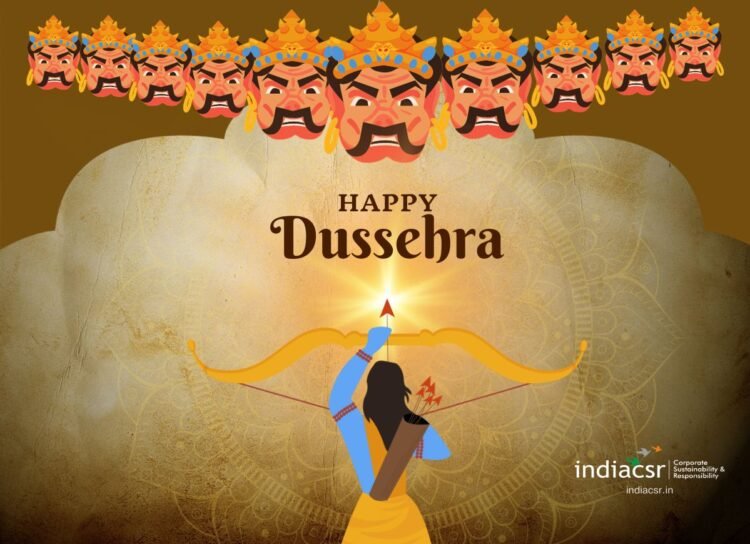Dussehra is celebrated in different ways across India, such as burning effigies of Ravana, taking out processions of idols, worshipping weapons, and exchanging gifts.
Dussehra is one of the most important and popular festivals in India. It is celebrated on the tenth day of the lunar month of Ashvin. It is also known as Vijayadashami, which literally means “victory on the tenth day”. Dussehra marks the end of the nine-day festival of Navratri, which is dedicated to the worship of Goddess Durga. Dussehra also commemorates the victory of Lord Rama over the demon king Ravana, who had abducted Rama’s wife Sita. Dussehra symbolizes the triumph of good over evil and the power of truth and righteousness.
The Legend of Rama and Ravana
According to the epic Ramayana, Rama was the prince of Ayodhya and the seventh incarnation of Lord Vishnu. He was exiled to the forest for 14 years by his stepmother Kaikeyi, who wanted her son Bharata to become the king. Rama was accompanied by his wife Sita and his brother Lakshmana. During their exile, they encountered many challenges and adventures, including meeting Hanuman, the monkey god, and forming an alliance with Sugriva, the king of monkeys.
One day, while Rama and Lakshmana were away, Ravana, the ten-headed king of Lanka, came in disguise and kidnapped Sita. He took her to his island kingdom and tried to force her to marry him. Sita remained faithful to Rama and refused to succumb to Ravana’s advances. Rama, with the help of Hanuman, Sugriva, and their army of monkeys and bears, crossed the ocean and reached Lanka. There, he fought a fierce battle with Ravana and his army of demons. After a long and bloody war, Rama finally killed Ravana with his divine arrow and rescued Sita. He then returned to Ayodhya with Sita, Lakshmana, Hanuman, and others, where he was welcomed by his people and crowned as the king.
The Celebration of Dussehra
Dussehra is celebrated in different ways across India, depending on the local traditions and customs. However, some common features are:
- The burning of effigies: In many places, especially in North India, huge effigies of Ravana, his brother Kumbhakarna, and his son Meghnad are made out of bamboo, paper, cloth, and firecrackers. These effigies are then set on fire in public places by shooting arrows at them. This signifies the destruction of evil by Rama’s arrow. People also watch fireworks and enjoy cultural programs on this occasion.
- The procession of idols: In some places, especially in South India, idols of Goddess Durga are taken out in processions on decorated vehicles or chariots. These idols are then immersed in water bodies such as rivers or lakes. This marks the end of Durga Puja and the return of the goddess to her heavenly abode.
- The worship of weapons: In some places, especially in Rajasthan and Gujarat, people worship their weapons and tools on this day. They believe that by doing so, they will be blessed with success and protection from enemies. This practice is also followed by some communities such as Rajputs, Kshatriyas, Marathas, Sikhs, etc., who have a martial tradition.
- The exchange of gifts: On this day, people also exchange gifts and sweets with their friends and relatives. They also wear new clothes and visit temples to seek blessings from God.
The Significance of Dussehra
Dussehra is a festival that teaches us many valuable lessons for life. Some of them are:
- It reminds us that good always prevails over evil and that truth always wins over falsehood.
- It inspires us to follow the path of dharma (righteousness) and to fight against adharma (unrighteousness).
- It encourages us to respect women and to protect them from harm.
- It motivates us to be loyal to our family and friends and to help them in times of need.
- It urges us to be brave and courageous in facing challenges and difficulties.
- It celebrates the diversity and unity of India’s culture and heritage.
Dussehra is a festival that fills us with joy and enthusiasm. It also instills in us a sense of duty and responsibility towards ourselves and others. It is a festival that honors our heroes and heroines who have sacrificed their lives for our freedom and dignity. It is a festival that glorifies our faith and devotion to God. It is a festival that makes us proud to be Indians.
Also Read: Dussehra 2024: Date, History, Significance, Celebrations and Important Facts






